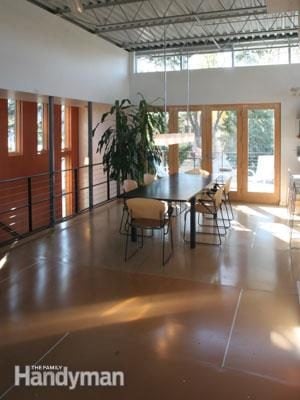Exploring MDF Flooring: Benefits, Challenges, and Practical Insights
Updated: Aug. 13, 2023
Medium-density fiberboard (MDF) has a ton of useful applications, but as a finished flooring material?

Medium-density fiberboard, commonly known as MDF, is renowned for its myriad applications in the world of woodworking. But who would’ve thought of it as a viable flooring solution? When it comes to finding affordable, temporary flooring options, MDF offers a unique solution. Here’s an in-depth look at our five-year experiment with MDF as a finished floor.
On This Page
A Bit of History
About half a decade ago, we found ourselves in need of an affordable flooring alternative for our 1,200-sq.-ft. upstairs addition. MDF seemed a suitable choice, even though its price has risen from what it once was – now clocking in at roughly $30 per sheet. Our goal was to use MDF as a ‘placeholder’ until we could upgrade. Yet, five years later, our “temporary” floor has remarkably stood the test of time.
The Process
Opting for inexpensive materials often demands a higher input of manual labor, and MDF flooring was no exception. We diligently laid out 4 x 8-ft. sheets of MDF across our living spaces, securing them with glue and screws. Though we chose to leave the screw heads visible, one could easily conceal them. Aesthetic appeal was added using ½-in. aluminum channels between sheets. This not only enhanced the visual appeal but was functional, accommodating the expansion and contraction due to our radiant in-floor heating. A thorough sanding followed, and we sealed the deal with three to four layers of polyurethane. One thing to remember if you’re considering MDF: its color varies. Different suppliers offer a range of browns, yellows, and tans.
The Good and the Not-so-Good
Pros:
- An economical choice compared to other flooring options.
- MDF is user-friendly.
- Offers stability and a solid feel underfoot.
- The floor’s aesthetic is commendable, drawing comparisons to concrete while retaining the warmth of wood.
Cons:
- MDF can release potentially harmful fumes, though sealing can mitigate this.
- It’s vulnerable to swelling upon contact with liquids.
- MDF is prone to scratches, a concern in areas like dining rooms where chairs are frequently moved.
What We Learned
- MDF batches can differ in color and texture. To maintain consistency, it’s best to buy what you need in one go.
- Applying polyurethane directly on MDF can lead to an uneven finish due to its porous nature. In hindsight, sealing the sheets before installation might have been better.
- MDF might not be the best choice for areas with high foot traffic or potential water exposure.